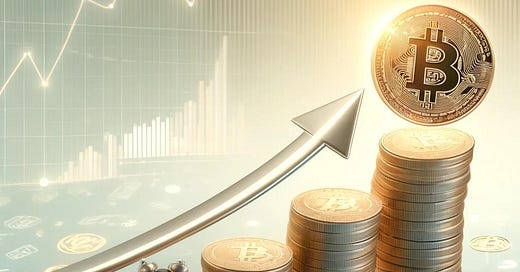Chasing FIRE is a low time preference game.
We’re not looking for a windfall of wealth to come from a single investment or business opportunity. Sure, that’s a proven way to generate riches if you can pull it off, but it comes with a much higher risk level and offers no guarantees of success.
Instead of taking concentrated risk over a short(ish) timeframe in hopes to strike it rich, the FIRE approach aims to build lasting wealth, little by little, over a longer period of time. The secret weapon? Compound returns.
Compound interest is the eighth wonder of the world. He who understands it, earns it. He who doesn't, pays it.
— Albert Einstein
This week, we’ll explore how compounding works, why understanding it is essential, and how to leverage its power to achieve FIRE faster.
🌱 The basics
Compound returns are created by “letting it ride.”
When making an investment of any kind, the goal is to walk away with more value than you put in. This is expressed as a rate of return (RoR), and we normally refer to it in annual terms. If after one year, an investment of $100 has grown to a value of $110, you’ve made an annual rate of return of 10%.
This also means that going into year two, your starting point is no longer $100, but $110. Assuming another 10% return in the second year brings the total value of your investment to $121.
In year one, your investment increased in value by $10. In year two, your investment increased in value by $11. You earned an extra $1 of value by “letting it ride” for an extra year.
Now, at the end of year two, your total return on the $100 invested is $21 (21%). If you let it ride for another year, and then another, and then another, what will be the result? A compounding effect that starts slow at first but grows exponentially.
After one year, you feel a ripple on the water. After ten years, a wave. After 30 years, a tsunami!
📈 Compound Annual Growth Rate (CAGR)
In the real world, your rate of return will vary from year to year. In some cases it will be negative, and you will lose value. However, we can look at the history of prices for a particular investment and calculate its compound annual growth rate for a particular timeframe. This CAGR number normalizes variable returns into a single number, similar to the 10% example used above.
Let’s look at the CAGR over the last 8 years for the total stock market index (VTI) and bitcoin (BTC).
By definition, the CAGR smoothes out the volatility in the price of an asset over the calculation period and paints a simple picture of its historical return profile. If you can be relatively confident that the historical CAGR of your investment will continue, you can make a prediction about the future. Past performance does not guarantee future performance, but playing around with these numbers can be a fun exercise.
📉 Debt can compound in reverse
Some FIRE proponents are fundamentally opposed to all debt. I take a more nuanced approach, which I’ll explore in a future issue. To put it simply, debt that does not compound and that carries a lower interest rate than your expected portfolio RoR can be used to build wealth faster.
However, debt that compounds, like outstanding credit card balances, gets dangerous quickly. Credit cards generally have very high interest rates, and a compounding effect of this debt can crush you.
Credit cards are a great tool for managing finances, but you need to be smart about it.
🚀 Compounding is rocket fuel for FIRE
Like a rocket launch, building a FIRE portfolio requires a lot of economic energy up front to get off the ground. The compounding effect is slow at first, but it gradually picks up speed over time. After a few years of intentional work, you’ll notice it’s much easier for your wealth to increase. The higher you go, the less gravity you feel, until you hit escape velocity, i.e. financial independence!
I’ll end this week’s issue with a few tips to maximize the effect of compounding so you can get into “orbit” faster:
Start NOW - the sooner you take an intentional approach to FIRE, the sooner you’ll get the compounding effect to work in your favor. As you can see in the charts above, time is your friend. Compounding gets more potent the longer you let it work for you.
Save more - Being intentional about your expenses and finding ways to save more adds fuel to your rocket engine. Increasing your earnings is a great way to grow your savings rate as well. Continually adding to your savings portfolio is a key factor in speeding up your FIRE journey.
Increase RoR - A higher rate of return means faster compounding. In Bitcoin is FIRE Friendly, I made the case for FIRE practitioners to consider adding bitcoin to their savings portfolio. I expect bitcoin’s RoR to far outpace that of any other asset over the next 10+ years.
Here’s a simplified calculation:
That’s it for this week. Thanks for reading!
💡 Enjoyed this content? Share FIRE BTC with someone who’d love to learn about financial independence and bitcoin!
Until next week,
Trey ✌️







👏🏼 loving the articles